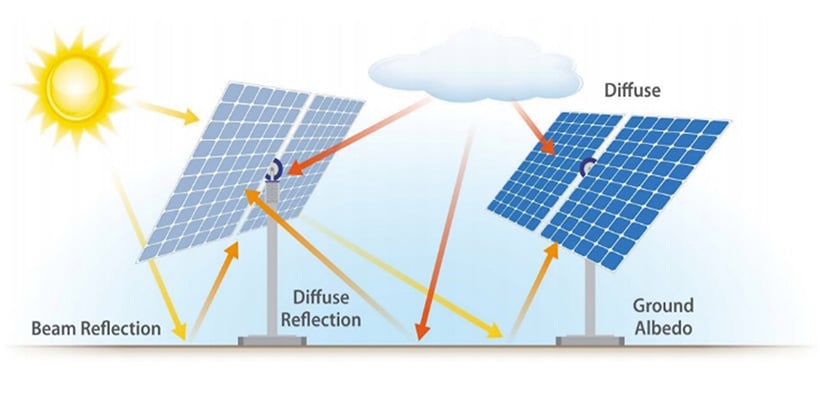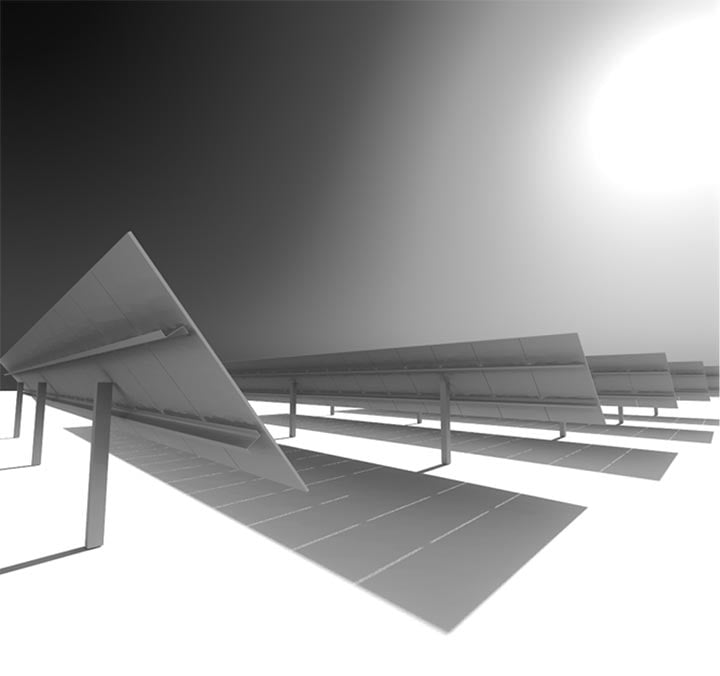Photovoltaic Bifacial Irradiance and Performance Modeling Toolkit
NLR's bifacial_radiance open-source toolkit enables accurate time-series bifacial photovoltaic (PV) irradiance and electrical data modeling as well as new insights into bifacial technology performance.
The toolkit provides functions and classes for simulating the performance of bifacial PV systems. Specific algorithms include design and layout of PV modules, reflective ground surfaces, shading obstructions, and irradiance calculations throughout the system.
Download bifacial_radiance
The software can be accessed from a GitHub repo with installation instructions and full documentation. AWS integration is also encouraged with Docker and sample scripts.

Accurate rear-irradiance conditions can be simulated through raytracing to understand the performance of bifacial photovoltaic systems.
Model Methodology
The bifacial_radiance methodology leverages accurate raytracing irradiance modeling for bifacial PV arrays, including:
- Visualization and rendering of the array scene as well as full simple customization of albedo, tilt, pitch, clearance height, and module-to-module spacing
- High-performance computing/cloud integration
- Calculation of shading, electrical mismatch, spectral effects, and edge effects due to finite system sizes
- Capability to model custom PV arrays and racking, including dual-use PV such as carports or agrovoltaic sites.
Other features include cell-level module modeling to account for partial transparency of modules, modeling of half-cell modules, and custom tracking algorithms.
PV performance modeling is powered by integration with PVlib routines to calculate power of the modules considering the output of bifacial radiance and temperature effects. PVMismatch routines for calculating electrical mismatch are also provided. Electrical mismatch values are also provided following the proposed methodology in Estimating and Parameterizing Mismatch Power Loss in Bifacial Photovoltaic Systems, Progress in Photovoltaics (2020).

Visualization of a bifacial photovoltaic array generated through bifacial_radiance. Graphic from J. Alderman
NLR's bifacial research group may be able to offer support to bifacial_radiance users with needs that go beyond the software's capabilities, such as :
- Reports on expected bifacial irradiance or energy gain, including design optimization with similar setups, shading factor calculation, and electrical mismatch evaluation
- Accurate prediction of the time-resolved annual energy yield modeling
- Support in making informed decisions in designing, executing, or financing bifacial solar PV.
Use the contact info at the bottom of this page to see if the team can support your needs.
Model Validation
bifacial_radiance has been validated with a rooftop installation, a fixed-field test bed, a 75-kW single-axis tracking field at NLR, and two 100-MW bifacial and one 100-MW-equivalent monofacial fields. See the Durable Module Materials Consortium website for open field data from the NLR single-axis tracking field.
bifacial_radiance has also participated in international round-robins to compare with other software tools.
How To Use the Model
See bifacial_radiance Training.
Publications
Comparison of Bifacial Solar Irradiance Model Predictions With Field Validation, IEEE Journal of Photovoltaics (2018)
Model and Validation of Single-Axis Tracking With Bifacial PV, IEEE Journal of Photovoltaics (2019)
A Comparison of Bifacial PV System Modelling Tools, BifiPV Workshop (2019)
Bifacial Photovoltaic Modules and Systems: Experience and Results From International Research and Pilot Applications, International Energy Agency Report (2021)
For more publications, see the PV Performance Modeling Collaborative: Bifacial PV Project.
How To Cite the Model
If you publish data generated by the bifacial_radiance model, please cite it accordingly:
Pelaez, Silvana Ayala and Chris Deline. 2020. "bifacial_radiance: A Python package for Modeling Bifacial Solar Photovoltaic Systems." Journal of Open Source Software. https://doi.org/10.21105/joss.01865.
Contacts
Share
Last Updated Dec. 6, 2025
